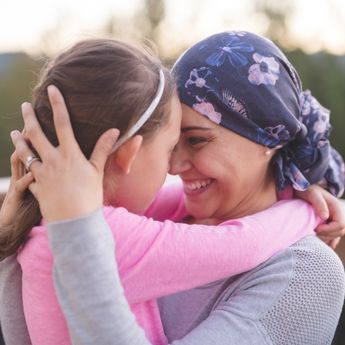A breast cancer diagnosis comes with so many questions and there never seems to be enough time at appointments to have some of these questions answered. To help address this, we developed a "Q&E: Questions and Experts" series. In this series, a variety of experts spend the entire virtual session answering pre-submitted and live questions from participants. Watching the videos on-demand might be a little difficult to get through. So, we’ve created this guide to help you get right to the questions and answers that matter the most to you.
In today’s post, we provide the questions that were sent in and asked during the live session of our Questions and Experts session held in April 2022. In this session, Dr. Jean Seely, Head of the Breast Imaging Section at the Ottawa Hospital, answered questions about breast screening and imaging after breast cancer. In the parentheses, you’ll find the timestamp of where to find the question in the on-demand video. Read our Screening AFTER Breast Cancer Advocacy Guide to learn more about follow-up surveillance for those who have had breast cancer and to learn how to advocate to access the appropriate testing.
Guidelines, recommendations, and standard-of-care in Canada
-
Is the PET scan with an FES tracer available in Canada, and if so, how widespread is it used? (00:12:27)
- Does the one-year follow-up time count from diagnosis or from when a patient finishes their treatment? (00:14:36)
- Does the one-year follow-up time change as time goes by without a new diagnosis? (00:17:37)
- Why does supplemental screening end at age 69? (00:19:27)
- What’s recommended in terms of surveillance for the average risk person who’s had a personal history of breast cancer? What then would be recommended for a high-risk woman, and how do you tell if you fall within that high-risk category? (00:21:47)
- Why don’t oncologists include MRIs for surveillance of women who’ve had breast cancer? Why is that not a standard-of-care? (00:30:57)
- Countries in the European Union are currently in the process of updating imaging screening guidelines based on breast density. For example, MRIs are recommended for people with very dense breasts. Is anything like this happening in Canada? (00:36:24)
- What do you think it would take for the imaging screening guidelines to be updated in Canada? (00:40:23)
- Do the Canadian Association of Radiologists guidelines recommend that radiologists include breast density information in diagnostic mammogram reports? (01:08:47)
- Are diagnostic, surveillance, and screening guidelines the same across Canada? (01:10:40)
- Is there any documentation or some type of supporting document available to help patients or high-risk individuals advocate for themselves to obtain an MRI or other types of surveillance? (01:14:46)
Breast imaging technologies
-
Can you explain what tomosynthesis is? (00:06:58)
- When is tomosynthesis in conjunction with a mammogram, ultrasound, and an MRI appropriate for surveillance after breast cancer? (00:06:58)
- Is the PET scan with an FES tracer available in Canada, and if so, how widespread is it used? (00:12:27)
- My understanding is that a PET scan that is done with an FES tracer is much more effective at imaging ER-positive cancers, like invasive lobular carcinoma, than if done with an FDG tracer. Is that true? (00:12:27)
- Is tomosynthesis the same as a 3D mammogram? (00:13:47)
- Traditionally, as part of the screening program, women receive mammograms. However, you spoke about MRIs as well as ultrasounds as being used for screening and surveillance of high-risk individuals. What role do these various modalities play for high-risk versus non-high-risk individuals? (00:27:19)
- Why don’t oncologists include MRIs for surveillance of women who’ve had breast cancer? Why is that not a standard-of-care? (00:30:57)
- Countries in the European Union are currently in the process of updating imaging screening guidelines based on breast density. For example, MRIs are recommended for people with very dense breasts. Is anything like this happening in Canada? (00:36:24)
- Are MRIs more cost-effective than mammograms? (00:41:50)
- For those with a double mastectomy, what should they be receiving in terms of surveillance? (00:44:57)
- This participant had DCIS in her left breast at age 55 in 2002. In 2019 she had nipple retraction on her left breast and was diagnosed with lobular invasive cancer which was treated with a lumpectomy and radiation at the age of 72. This was not detected on any of her mammograms or ultrasounds over 17 years, but on an MRI; it was a very large tumour. She is not eligible for MRI screening due to her age, however, she can afford a private MRI. Is this something that you would recommend for a patient with her history, and if so, how often should she have an MRI done? (00:51:50)
- Does a high Oncotype DX score make a difference in the type of surveillance that should be done? (00:55:20)
- Does the location of the first cancer have any bearing on what modalities you may choose to use in ongoing surveillance? (00:56:01)
- What type of imaging should be done for someone diagnosed with stage IV breast cancer? (01:00:35)
- Is there any documentation or some type of supporting document available to help patients of high-risk individuals advocate for themselves to obtain an MRI or other types of surveillance? (01:14:46)
- How are blood tests used during a mammogram to detect recurrence? (01:02:13)
- Is there a chance that a mammogram could spread cancer cells to the lymph nodes? (01:05:00)
Diagnostic imaging, screening, and surveillance
-
Can you explain the difference between breast cancer screening and surveillance? (00:03:38)
- Is the process of breast imaging done differently for surveillance versus screening? (00:05:08)
- When is tomosynthesis in conjunction with a mammogram, ultrasound, and an MRI appropriate for surveillance after breast cancer? (00:06:58)
- What’s recommended in terms of surveillance for the average risk person who’s had a personal history of breast cancer? What then would be recommended for a high-risk woman, and how do you tell if you fall within that high-risk category? (00:21:47)
- Does a high Oncotype DX score make a difference in the type of surveillance that should be done? (00:55:20)
- Does the location of the first cancer have any bearing on what modalities you may choose to use in ongoing surveillance? (00:56:01)
- Are diagnostic, surveillance, and screening guidelines the same across Canada? (01:10:40)
- What would you say is the minimal surveillance that should be done for patients as follow-up care? (01:18:29)
-
Do the general practitioners know about the Ikonopedia or CanRisk and BOADICEA tools that help individuals calculate their lifetime risk of breast cancer? (00:25:53)
- Is the risk of recurrence different for the various subtypes of breast cancer? (00:33:43)
- Where can patients find information on risk of recurrence for their stage and subtype of breast cancer? (00:48:33)
- Would a radiologist or an oncologist have information about risk of recurrence? (00:48:33)
- How are blood tests used during a mammogram to detect recurrence? (01:02:13)
Dense breasts and high-risk individuals
-
What’s recommended in terms of surveillance for the average risk person who’s had a personal history of breast cancer? What then would be recommended for a high-risk woman, and how do you tell if you fall within that high-risk category? (00:21:47)
- Traditionally, as part of the screening program, women receive mammograms. However, you spoke about MRIs as well as ultrasounds as being used for screening and surveillance of high-risk individuals. What role do these various modalities play for high-risk versus non-high-risk individuals? (00:27:19)
- Countries in the European Union are currently in the process of updating imaging screening guidelines based on breast density. For example, MRIs are recommended for people with very dense breasts. Is anything like this happening in Canada? (00:36:24)
- Are there dietary factors that are associated with dense breast tissue? (00:43:10)
- Do the Canadian Association of Radiologists guidelines recommend that radiologists include breast density information in diagnostic mammogram reports? (01:08:47)
- Is there any documentation or some type of supporting document available to help patients of high-risk individuals advocate for themselves to obtain an MRI or other types of surveillance? (01:14:46)
Lymph nodes, tumors, and breast cancer types
-
My understanding is that a PET scan that is done with an FES tracer is much more effective at imaging ER-positive cancers, like invasive lobular carcinoma, than if done with an FDG tracer. Is that true? (00:12:27)
- Is the risk of recurrence different for the various subtypes of breast cancer? (00:33:43)
- Where can patients find information on risk of recurrence for their stage and subtype of breast cancer? (00:48:33)
- If the cancers are in the lymph nodes, is that considered stage III or stage IV? (00:50:05)
- What are microscopic cells in the lymph nodes? (00:50:50)
- This participant had DCIS in her left breast at age 55 in 2002. In 2019 she had nipple retraction on her left breast and was diagnosed with lobular invasive cancer which was treated with a lumpectomy and radiation at the age of 72. This was not detected on any of her mammograms or ultrasounds over 17 years, but on an MRI; it was a very large tumour. She is not eligible for MRI screening due to her age, however, she can afford a private MRI. Is this something that you would recommend for a patient with her history, and if so, how often should she have an MRI done? (00:51:50)
- Where are the most typical locations of a tumour in the breast? (00:57:42)
- What type of imaging should be done for someone diagnosed with stage IV breast cancer? (01:00:35)
- Is there a chance that a mammogram could spread cancer cells to the lymph nodes? (01:05:00)
- Can having a core-needle biopsy of a lymph node make cancer cells spread faster to other areas? (01:12:20)
Photo by Lukas from Pexels







